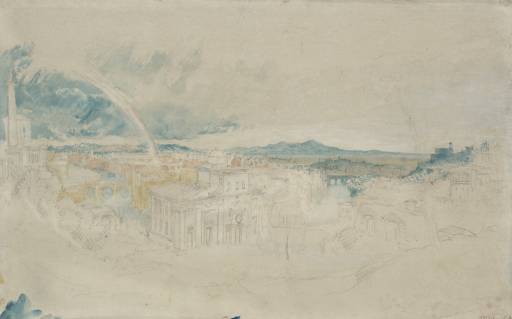Joseph Mallord William Turner View of Rome with a Rainbow, from the Gardens of the Villa Barberini 1819
Joseph Mallord William Turner,
View of Rome with a Rainbow, from the Gardens of the Villa Barberini
1819
Joseph Mallord William Turner 1775–1851
View of Rome with a Rainbow, from the Gardens of the Villa Barberini 1819
D16327
Turner Bequest CLXXXIX 1
Turner Bequest CLXXXIX 1
Pencil, watercolour and grey watercolour wash on white wove ‘Valleyfield’ paper, 232 x 370 mm
Inscribed by an unknown hand in blue ink ‘F.8’ bottom right
Stamped in black ‘CLXXXIX 1’ bottom right
Inscribed by an unknown hand in blue ink ‘F.8’ bottom right
Stamped in black ‘CLXXXIX 1’ bottom right
Accepted by the nation as part of the Turner Bequest 1856
Exhibition history
1904
National Gallery, London, various dates to at least 1904 (251).
1995
Sketching the Sky: Watercolours from the Turner Bequest, Tate Gallery, London, September 1995–February 1996 (no number).
2007
Colour and Line: Turner’s Experiments, Tate Britain, London, November 2007–October 2008 (no catalogue).
References
1904
E.T. Cook and Alexander Wedderburn (eds.), Library Edition: The Works of John Ruskin: Volume XIII: Turner: The Harbours of England; Catalogues and Notes, London 1904, no.251, pp.384, 622, as ‘Rome’.
1909
A.J. Finberg, A Complete Inventory of the Drawings of the Turner Bequest, London 1909, vol.I, p.562, as ‘Rome. Exhibited Drawings, No.251, N.G.’.
1920
D[ugald] S[utherland] MacColl, National Gallery, Millbank: Catalogue: Turner Collection, London 1920, p.86.
1984
Cecilia Powell, ‘Turner on Classic Ground: His Visits to Central and Southern Italy and Related Paintings and Drawings’, unpublished Ph.D thesis, Courtauld Institute of Art, University of London 1984, p.122.
Turner’s location for this view of Rome was the Villa Barberini (also known as the Villa Barberini al Gianicolo), a small Baroque casino situated north of the Janiculum Hill, to the immediate south of St Peter’s and the Vatican. Originally owned by Taddeo Barberini, nephew of Pope Urban VIII, the building was largely destroyed during the siege of Rome in 1849,1 but its appearance is partially recorded in an eighteenth-century engraving by Giuseppe Vasi (1710–1782).2 Two small pavilions, the Casino della Palma, and the Palazetto Vercelli survived and are today part of a larger complex owned by the Jesuits and the Collegio di Propoganda Fide.
During the nineteenth century, the Villa Barberini was set within terraced gardens which offered spectacular views across the city. This sketch of the easterly prospect depicts the River Tiber at a point where it curves in front of St Peter’s. The viewer therefore looks simultaneously upstream (or left) towards the Ponte Sant’Angelo and downstream (right) towards the Ponte Sisto. In the foreground are architectural features of the Villa Barberini gardens and in the centre is the Baroque façade of the Casino itself, designed by Giovanni Battista Contini. In the background, Turner has loosely recorded the topography of the city which encompasses a sweep of approximately ninety degrees from the Castel Sant’Angelo on the left, to the Janiculum Hill and the silhouette of San Pietro in Montorio on the right. Several other panoramic studies from the Villa Barberini can be found within this sketchbook (see D16329, D16333, D16347, D16358, D16361, D16374; Turner Bequest CLXXXIX 3, 7, 21, 32, 34, 45a) and there is also a single related sketch in the Albano, Nemi, Rome sketchbook (see Tate D15368; Turner Bequest CLXXXII 39).
Like many drawings within the Rome C. Studies sketchbook, the composition has been executed in pencil over a washed grey background and the artist has added a small amount of watercolour to partially colour the line of the horizon. The use of blue for the distant mountains beyond recalls the effects of aerial perspective which characterise the paintings of the seventeenth-century master Claude Lorrain (circa 1600–1682). In addition to recording the towers and roofs of the city Turner has also introduced a naturalistic sense of atmospheric conditions. He has used liquid paint and energetic, free brushwork to describe the blustery clouds and rainbow within the sky on the left.
Verso:
Blank, except for traces of grey watercolour wash; inscribed by an unknown hand(s) in pencil ‘1’ encircled, centre and ‘CLXXXIX.1’ bottom centre right, and stamped in black ‘CLXXXIX 1’ centre left.
Nicola Moorby
July 2009
How to cite
Nicola Moorby, ‘View of Rome with a Rainbow, from the Gardens of the Villa Barberini 1819 by Joseph Mallord William Turner’, catalogue entry, July 2009, in David Blayney Brown (ed.), J.M.W. Turner: Sketchbooks, Drawings and Watercolours, Tate Research Publication, December 2012, https://www

